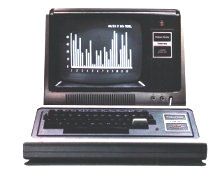Welcome to my website!
Buckle
up and get ready to take a journey down "Nerdville" as I give you a
guided tour of the many computer projects that I have accomplished from
the day my parents bought me my first personal computer... under
the pretence that it will "help me with my homework". 
A little bit of history
My name is Nickolas Marentes and I live in Brisbane, Australia.
I started with computers back in 1979 when I would drop in to the local Radio
Shack/Tandy store after school to play with the TRS-80 Model 1 that was on
display.
After getting my own TRS-80 in 1980, I had a desire to start a software company
and create commercial grade games. I started under the name "Supersoft Software"
which was later changed and officially registered as "Fun Division". It was
a small "cottage company" and sales were only small but I was a high school
kid at the time and anything I earned was good money.

My TRS-80 Model 1 had 16K of RAM (upgraded later internally to
32K), low resolution 128 x 48 monochrome graphics and no disk drive. I learned
how to program it's Z-80 8-bit microprocessor and developed all my TRS-80
Model 1 games on this setup using a cassette player for data storage.
By 1984, the TRS-80 was showing it's age so I decided to move up to something
newer with high resolution and color graphics. Being familiar with the Radio
Shack/Tandy line, I chose the Tandy Color Computer complete
with 64K RAM and dual floppy disk drives. 
Although
it wasn't as graphically impressive as many of the other competing systems
on the market at the time, it had two important attributes. Firstly, it had
a great CPU, the Motorola 6809. Secondly, it had a large distribution channel
via the many Radio Shack/Tandy stores which I had hoped to exploit for my planned
future rise to stardom and obsene riches. In 1986, Tandy
released the Color Computer 3 with improved graphics, more memory and faster
speed. The future was looking bright till...
In 1992, Tandy decided to discontinue the Color Computer and so I decided
to move on to the Commodore Amiga. Due to lifestyle changes, I never did
create any software for the Amiga but in 1997, the bug caught me again and
I returned to the Tandy Color Computer. I found that a dedicated group of
faithful users still existed so I re-entered the CoCo community. To this day, I continue to create games for this computer, nowadays just as a hobby. What's this site
about?
I have designed this site to be read sequencially from the first project
to the last so that you can see the progression of events, ideas and decisions
that were made as time went on.
As
I detail each project on this site, you will read about my dreams and
desires for each project, the challenges I experienced during their
development and the inspiration and motivation behind them. I will show
you how I achieved everything on a shoe string budget using very
limited development tools and cover the post product development stage
which involved documention, packaging and marketing, all of which I had
to do myself.
Those were days in which it was easier for one person to create a small software
company operated from a bedroom office to create and market a few video game
programs. Today, the games are far more complex and software houses employ
many people and cost thousands, even millions of dollars to produce.
I enjoyed doing each of these projects and I am grateful to those who supported
my efforts by purchasing my products over the years.
|